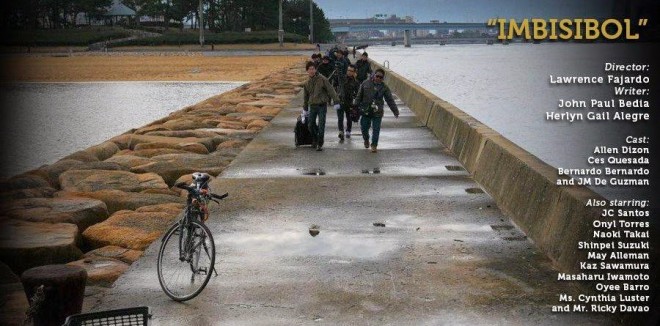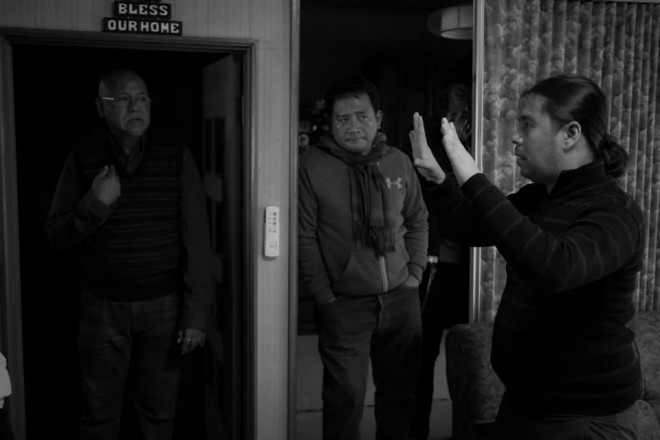
Right after “Imbisibol’s” curtain call at the Virgin Labfest 9 in 2013, director Lawrence Fajardo already knew that the one-act play would be good material for the big screen.
“I knew I wanted to make a film out of it, based on the reaction of the audience,” he said.
But it would take two years and three revisions of the story before it made its debut last month at the first Sinag Maynila Film Festival, where it eventually bagged seven of the eight awards, including Best Picture and Best Director.
“Imbisibol,” written by Herlyn Alegre, a creative writing cum laude graduate of the University of the Philippines in Diliman, tackles the plight of displaced Filipinos in Japan in the 1990s. Its film version, cowritten by Alegre, Fajardo and John Bedia, takes a deeper look at the lives of the story’s four characters—Linda (Ces Quesada), Benjie (Bernardo Bernado), Manuel (Allen Dizon) and Rodel (JM de Guzman), and the events leading to the play’s climactic scene.
Excitement
Fajardo said that the “excitement” to turn the first play he directed in over a decade into a film built up right after Virgin Labfest 10, where it was one of three plays re-showcased from the previous year’s lineup.
The opportunity to turn “Imbisibol” into a movie presented itself when acclaimed director Brillante Mendoza asked Fajardo, and four other directors, in October 2014 to submit two concepts for the maiden Sinag Maynila filmfest.
Fajardo then submitted “Imbisibol” and a family drama about drugs similar to Zig Dulay’s “Bambanti.” But while he wanted to make a movie adaptation of the play, Fajardo was hoping that “Imbisibol” wouldn’t be picked.
“The grant was only P2 million, and we knew that the production of ‘Imbisibol’ would be costly,” Fajardo said. Producer Krisma Fajardo seconded that “anyone in their right mind wouldn’t think you’d be able to shoot in Japan, in its entirety, with just P2 million.”
But lo and behold, Sinag Maynila chose “Imbisibol.” Fajardo said that since the story is set in Japan, he knew then that producing the film would be a “headache.”
“I had no choice. [But] we said, let’s do it. We were all happy, and it’s everyone’s dream to make the film after all,” said Fajardo.
Fortunately, Krisma said they were given by the filmfest organizers the leeway to look for a coproducer, Likhang Silangan, because they knew the film needed to be shot in Japan.
Since they had already staged “Imbisibol” twice, Fajardo thought that filming it would be “a walk in the park.” But “it turned out to be difficult,” he said. Krisma admitted that making the movie was “even more difficult than when you start a concept from scratch, because here you have a basis.”

Collaborative
By the time “Imbisibol” was set to become a movie, its script had undergone revision three times.
The first was before its original run at the Cultural Center of the Philippines’ Tanghalang Huseng Batute. Fajardo recalled VL artistic director Tuxqs
Rutaquio’s comment during one rehearsal: “Ay naiba na pala, noh? Pero maganda.”
“I didn’t know then if I had to stick to the script or if I was allowed to tweak,” Fajardo said. He had accepted Rutaquio’s offer to direct “Imbisibol” because he felt he was becoming too comfortable with filmmaking.
“I think I was the only one who had the gall to ask the playwright [to tweak the script]. In a way, I may be wrong. But I just wanted to absorb what [Alegre] wanted to say, and I wanted us to be collaborative, since I had already made a film about OFWs (overseas Filipino workers) and I know the feeling of being left behind,” Fajardo, whose father worked as a seaman for 31 years, explained.
The second revision came when Lui Manansala (Linda) and Lou Veloso (Benjie) did not reprise their roles in the rerun of the play. Quesada and Bernardo took over the roles, respectively.
In the original run, Fajardo said Benjie wasn’t as gay as he was in the rerun, which came to be because Bernardo initially seemed uncomfortable with the part. Fajardo allowed the actor to play the character his way.
“The track of Benjie’s story changed. We already had the script but we still had to improvise. [What’s different with] ‘Imbisibol’ is that every time you saw it live, it was like there was something new. That’s because I allowed them to improvise as long as they returned to the story’s track,” Fajardo said.
By the second run, Alegre was already in Tokyo for her doctorate in international studies. Fajardo relayed to her the changes online.

Back story
The third and last revision was for the movie, whose script Fajardo said was difficult to connect to the play.
“We wanted to be faithful to the play. It’s very difficult to connect it. But, in connecting the back story to the play, we learned a lot. My approach toward filmmaking became behavioral. This is not just a story; I’m telling the behavior of a bilog (illegal migrant worker): how he eats, walks, interacts; what’s his behavior when he’s among the crowd. That’s the study of ‘Imbisibol’—how does an ‘imbisibol’ get to have his own identity?”
He said that “Imbisibol” was brought to life from Virgin Labfests 9 and 10 to its movie version because of the improvisation and inputs of the actors—Onyl Torres (Manuel), Amando Quintana, Jr. (Rodel), Manansala, Veloso, Quesada and Bernardo.
For Fajardo and Alegre, it is important that the play be shown on the big screen.
“When your father or mother is taking a photo in the snow smiling, seemingly happy, what happens after that? What do they look like after? That’s the thesis of ‘Imbisibol,’” said the director. “These people are working [for their families] and are sacrificing a lot. Sometimes, they are even forced to do bad [things] in order to do good—those are the ‘imbisibol.’”

Toned down
Movies or plays that depict the plight of Filipino workers in their host countries or the troubled household they return to aren’t something new to a nation with an estimated 10 million overseas workers.
Fajardo said what sets the movie version of “Imbisibol” apart is that it is “toned down and realistic in approach.”
“As in a play, you’re just watching the story unveil in front of you. Though [the running time] is two hours, you can see in the movie the simulation of boredom in snowy Hokkaido,” he explained.
He recalled that when they were done shooting a scene, it came upon him how depressing the place was.
“Much more if you’re someone who’s always hiding and doesn’t have anyone else to talk to. That’s the difference [of ‘Imbisibol’]—it’s more realistic. The lives of these characters are already dramatic, you don’t need to dramatize them further,” said Fajardo.
By bringing “Imbisibol” from the stage to the screen, Fajardo said he hopes the audience would realize the hardships of their relatives abroad. “[Through ‘Imbisibol’], they get to see and experience the life of overseas workers.”













































